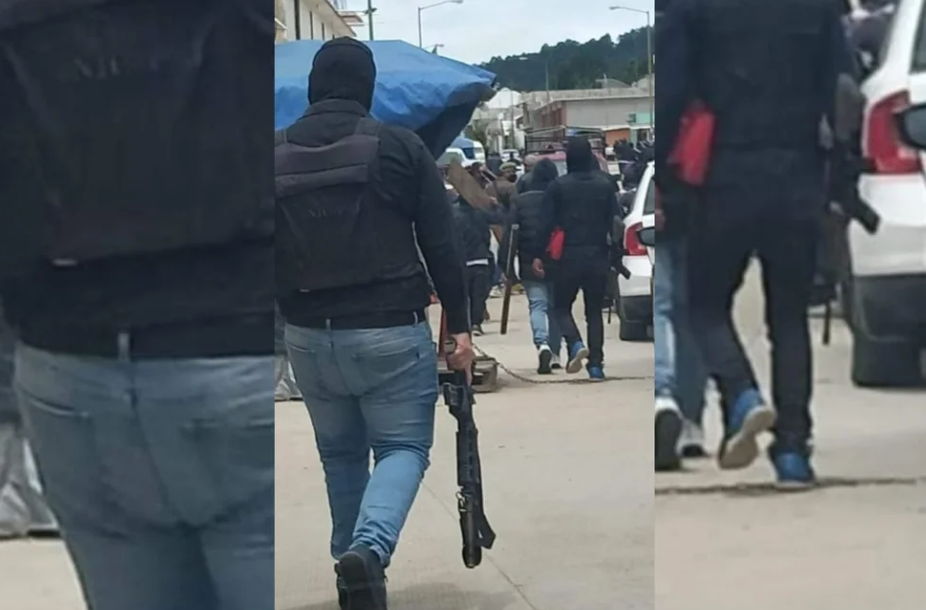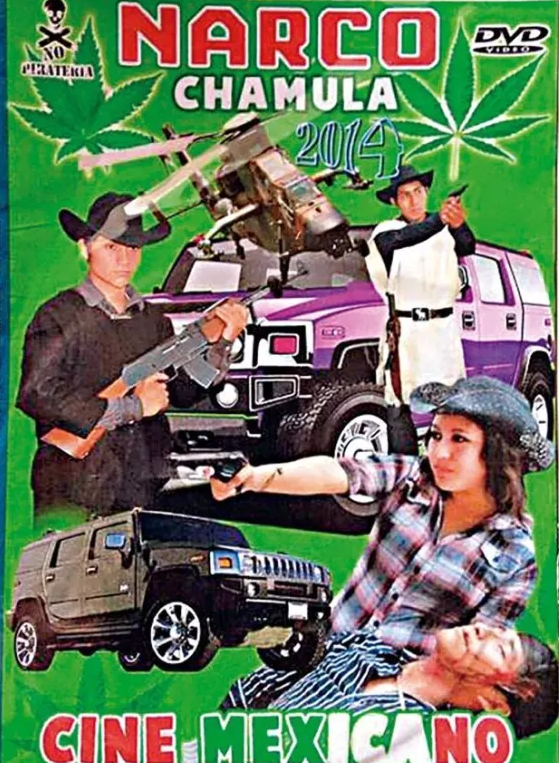
by Luís Hernández Navarro
Panic and anxiety. These are the words that sum up what thousands of inhabitants of San Cristóbal experienced for hours on this past June 14th, when dozens of armed civilians, hooded and with bulletproof vests, fired Kalashnikov and AR-15 rifles, blocked avenues and streets with tractor trailers and painted walls, challenging control of the North Market of the city. They sought to remove its longtime administrator, Domingo Pishol, representative of Hugo Pérez, the self-proclaimed mayor of Oxchuc.
With the sound of the first bursts of gunfire, people had to take cover or drop to the ground in stores, schools, clinics and businesses, fearful of being hit by a projectile. The shots are frequent in that part of the city, but on this occasion, they were unusually intense.
The existence of delinquent groups in Chiapas is not novel. It began to grow during the governorship of Juan Sabines (2006-12). But in recent years, across vast areas of the state, their presence and demands for territory, routes and markets have intensified. Guatemala is an immense storehouse in service to the criminal industry. From there, through the porous Chiapanecan border, in the direction of the United States and different regions of Mexico, come the drugs, guns, piracy, human beings, and stolen vehicles. Controlling the border and these roads is fundamental in moving the merchandise. The corridor of Frontera Comalapa to Comitán to San Cristóbal to Tuxtla has acquired great importance in the shuffle of drugs.

A couple of examples, among many. In Tuxtla Gutierrez in July of 2021, the Jalisco New Generation cartel, now experiencing dizzying expansion in the state, executed El Junior, son of the leader of the Sinaloa cartel in Chiapas. The rapid growth of the Chamula cartel, evidenced by the non-stop accidents of vehicles loaded with Central American migrants and the broadcasting of their narcocorridos 1.
San Cristóbal is no stranger to this war. Like other tourists sites, like Cancún or Acapulco, it is a desirable enclave for organized crime. In this city, at least five known groups (some say that there are eight) with complete immunity, like the motonetos or motopandilleros, linked to narcomenudeo (drug trade) charge for right of entry, steal, kill and fire into the air, sowing terror and uncertainty. (https://bit.ly/3OaDMs0). They emerged as a shock group during the administratio of Marco Antonio Cancino Gonzalez (2015-18), of the PVEM (Green Ecologist Party of Mexico.) His brother Sergio Natarén managed them. The battle for the control of the North Market on June 14th forms part of this plot in the state and in the city.
A key figure in the dispute is Martín Pale Santiz, alias El Gemelo, leader of the Coordination of Organizations for the Environment for a Better Chiapas (Comach), with close ties to the state government, once arrested for extortion and later released. His people are capable of strangling San Cristóbal, blocking access to roads while confronting other groups with guns and sticks. They are also able to evict and beat families from Santa Catarina, members of the People’s Campesino Front of Chiapas, to take five hectares (https://bit.ly/3n3Fmjm). With the support of Gerónimo Ruiz Sántiz, El Moshán, they charge 800 thousand pesos weekly to some 200 street vendors (whom they control) in the Plaza de la Paz (in front of the Cathedral), Andadores (the tourist pedestrian corridors), the Santo Domingo (artisan market) and the Historic Center.
One person was killed in the operation: Xalik. It was reported that he had been hit by a stray bullet. Civil defenders of San Cristóbal pointed out that he was a young tzotzil man who openly opposed the recruitment of children into armed groups in Chamula. This young man had separated from his clan lineage, distancing himself from these dynamics that now permeate many Chamulan families. But not only that. He was dedicated precisely to organizing the children in the street and especially those who walk the market in this zone. This is one death that is very convenient for some.
The partial seizure of the city is only just one more incident in the interminable chain of violence that shakes the state. This past June 8th, 30 kilometers from San Cristóbal, the mayor of Teopisca, Rubén de Jesús Valdez Díaz, was assassinated in a truck outside of his home.
The list of aggressions is unending. According to the Fray Bartolomé de las Casas (Frayba) Center for Human Rights, during March of this year alone, there were 437 firearm attacks of the narco paramilitary group of Santa Martha, Chenalhó against the community of Aldama (https://bit.ly/3n0TVEt).
Likewise, the attacks against the Zapatista support base families in the autonomous community of Nuevo San Gregorio have intensified, which put their life, security and integrity at risk (https://bit.ly/39FbA1s).
In this context, the Diocese of San Cristóbal de las Casas and other organizations made a joint pronouncement in the face of the unstoppable increase of violence in Chiapas, in which they expressed their concerns about the presence of heavily armed groups in the territory.
They also express their preoccupation about the constant aggressions, persecution and surveillance of defenders of human rights in our country and in Chiapas, primarily against those who defend land and territory.
They denounce that on May 29th, Manuel Santiz Cruz, Tseltal indigenous man, and president of the Human Rights Committee of San Juan Evangelista, municipality of San Juan Cancuc, was arbitrarily detained and deprived of his freedom along with four other people. (https://bit.ly/39D6G53).
Fear and uncertainty. In Chiapas, the violence, far from ceasing, grows and intensifies. Let no one be surprised when what is about to happen happens.
This article was published in La Jornada on June 21, 2022. https://www.jornada.com.mx/2022/06/21/opinion/018a1pol English translation by Schools for Chiapas.
